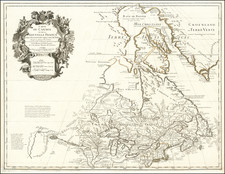Rare first state of the English edition of Lahontan's map of the mythical Longue River, running from a Mythical Lake on the east side of the Rocky Mountains direclty to the Mississippi River, just north of the Oisconsin River, and depicting a number of relatively short portages across the High Mountains to what must be inferred as the River of the West. The explanatory note indicates the map is based upon a map drawn upon Stag-skins by the Gnacsistares [Indians] who have it to Lahontan. The second note indicates that Lahontan's route is marked with the various camp sites and portages which Lahontan himself visited (he relies upon the Stag-skin map for the second half of his apocryphal journey). Despite the fanciful elements of the work, the Longue River appeared on maps for over a century after Lahontan's voyage and the map is a cartographic landmark. Louis-Armand de Lom d'Arce, baron de Lahontan, went to Canada with the Bourbon Regiment in the 1680s. After serving in Western Canada, he returned east in 1688 and claimed to have traveled to the northern portions of the Mississippi River and to the villages of the Osage Indians on the Missouri River, but it was his description of the Longue River which captivated adventurers looking for a water route to the Pacific. While the report was widely discredited, Thomas Jefferson deemed it an important work. A fine example, engraved by a young Herman Moll. An essential map for American Collectors.
Herman Moll (c. 1654-1732) was one of the most important London mapmakers in the first half of the eighteenth century. Moll was probably born in Bremen, Germany, around 1654. He moved to London to escape the Scanian Wars. His earliest work was as an engraver for Moses Pitt on the production of the English Atlas, a failed work which landed Pitt in debtor's prison. Moll also engraved for Sir Jonas Moore, Grenville Collins, John Adair, and the Seller & Price firm. He published his first original maps in the early 1680s and had set up his own shop by the 1690s.
Moll's work quickly helped him become a member of a group which congregated at Jonathan's Coffee House at Number 20 Exchange Alley, Cornhill, where speculators met to trade stock. Moll's circle included the scientist Robert Hooke, the archaeologist William Stuckley, the authors Jonathan Swift and Daniel Defoe, and the intellectually-gifted pirates William Dampier, Woodes Rogers and William Hacke. From these contacts, Moll gained a great deal of privileged information that was included in his maps.
Over the course of his career, he published dozens of geographies, atlases, and histories, not to mention numerous sheet maps. His most famous works are Atlas Geographus, a monthly magazine that ran from 1708 to 1717, and The World Described (1715-54). He also frequently made maps for books, including those of Dampier’s publications and Swift’s Gulliver’s Travels. Moll died in 1732. It is likely that his plates passed to another contemporary, Thomas Bowles, after this death.









![[Eastern Sheet -- Ohio] Post Road Map of the States of Ohio and Indiana with Adjacent Parts of Pennsylvania Michigan Illinois Kentucky and West Virginia Showing Post Offices With The Intermediate Distances and Mail Routes In Operation On the !st of February 1885 . . .](https://storage.googleapis.com/raremaps/img/small/44153.jpg)
![[Mormon Trail] Utah And the Overland Routes to it, from the Missouri River: Published with](https://storage.googleapis.com/raremaps/img/small/66366.jpg)
![[ Southern Railroads ] Railroad Map of the Southern States Shewing the Southern & Southwestern Railway Connections With Philadelphia. 1862 . . . Prepared by Thomas Kimber Jr., Chairman of the Committee on Inland Transportation of the Board of Trade of Philadelphia](https://storage.googleapis.com/raremaps/img/small/103211.jpg)

![[DeWitt Clinton Copy] An Account of Expeditions to the Sources of the Mississippi, and through the Western Parts of Louisiana, to the Sources of the Arkansaw, Kans, La Platte, and Pierre Jaun, Rivers During the years 1805, 1806 and 1807. And a Tour through the Interior Parts of New Spain. in the year 1807.](https://storage.googleapis.com/raremaps/img/small/81745.jpg)
